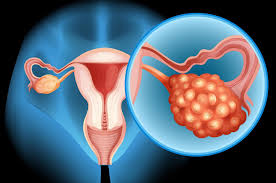What is ovarian cancer?

Ovarian cancer is a type of cancer that begins in the ovaries, the two small, almond-shaped organs located on either side of the uterus in a woman’s lower abdomen. The ovaries are a crucial part of the female reproductive system, responsible for producing eggs (ova) as well as the hormones estrogen and progesterone, which regulate the menstrual cycle and reproductive functions.
Ovarian cancer occurs when abnormal cells in the ovary begin to grow uncontrollably, forming a malignant tumor. Unlike some other cancers, ovarian cancer often remains undetected in its early stages because symptoms can be subtle or easily mistaken for other common conditions. This stealthy nature makes ovarian cancer one of the more challenging gynecologic cancers to diagnose early.
Types of Ovarian Cancer
Ovarian cancer is not a single disease but consists of several different types, classified based on the type of cells from which the cancer originates:
Epithelial Ovarian Cancer: This is the most common form, accounting for about 85-90% of ovarian cancers. It starts in the thin layer of cells covering the ovary’s surface. This type usually affects older women, particularly those who have gone through menopause.
Germ Cell Tumors: These cancers develop from the cells that produce eggs. Germ cell tumors are rare and tend to affect younger women, often in their teens and early 20s. Many germ cell tumors are benign, but some can be malignant.
Stromal Tumors: These arise from the connective tissue cells that hold the ovary together and produce female hormones. Stromal tumors are also rare and generally diagnosed earlier than epithelial cancers because they often cause hormonal symptoms.
Other Rare Types: There are also other rare ovarian cancers, including small cell carcinomas and carcinosarcomas, each with unique characteristics and treatment approaches.
Causes and Risk Factors
The exact cause of ovarian cancer remains unclear, but researchers have identified several risk factors that increase the likelihood of developing the disease:
Age: The risk of ovarian cancer increases as a woman ages, especially after menopause.
Family History and Genetics: Women with a family history of ovarian, breast, or colorectal cancer are at higher risk. Mutations in genes such as BRCA1 and BRCA2 significantly increase ovarian cancer risk.
Reproductive History: Women who have never been pregnant or had children later in life face a higher risk.
Hormone Replacement Therapy (HRT): Prolonged use of estrogen hormone replacement therapy may raise the risk.
Endometriosis: A condition where tissue similar to the lining inside the uterus grows outside the uterus, which may increase the risk.
Obesity and Lifestyle Factors: Excess body weight and certain lifestyle factors might contribute, although more research is needed.
Symptoms of Ovarian Cancer
One of the biggest challenges with ovarian cancer is that symptoms often mimic those of less serious conditions such as gastrointestinal issues or bladder problems. Common symptoms include:
Abdominal bloating or swelling
Pelvic or abdominal pain or discomfort
Difficulty eating or feeling full quickly
Urinary urgency or frequency
Changes in bowel habits, such as constipation
Unexplained weight loss or gain
Fatigue
Menstrual irregularities or abnormal vaginal bleeding
Because these symptoms are common and nonspecific, they can be easily overlooked or attributed to other causes. However, if these symptoms persist for more than a few weeks or worsen, it is essential to consult a healthcare professional.
Diagnosis
Diagnosing ovarian cancer typically involves several steps and tests:
Medical History and Physical Exam: The doctor will inquire about symptoms, family history, and perform a pelvic exam.
Imaging Tests: Ultrasound, CT scans, or MRI may be used to look for masses or abnormalities in the ovaries.
Blood Tests: CA-125 is a tumor marker often elevated in ovarian cancer, though it can be raised in other conditions as well.
Biopsy and Surgery: The definitive diagnosis usually requires tissue samples. Often, surgery is performed both to diagnose and remove the tumor.
Early-stage ovarian cancer is rarely diagnosed because it tends not to cause obvious symptoms. Unfortunately, many cases are detected at advanced stages when the cancer has spread beyond the ovaries.
Staging of Ovarian Cancer
Ovarian cancer is classified into stages based on the extent of spread:
Stage I: Cancer confined to one or both ovaries.
Stage II: Cancer has spread to pelvic structures such as the uterus or fallopian tubes.
Stage III: Cancer spread to the lining of the abdomen or lymph nodes.
Stage IV: Cancer has spread to distant organs like the liver or lungs.
The stage at diagnosis greatly influences prognosis and treatment options.
Treatment Options
Treatment depends on the cancer’s type, stage, and the patient’s overall health. The primary treatments include:
Surgery: Usually the first step, aiming to remove the tumor, affected ovaries, fallopian tubes, uterus, and as much cancer as possible.
Chemotherapy: Uses drugs to kill cancer cells, often given after surgery to eliminate remaining cancer.
Targeted Therapy: Newer drugs focus on specific molecular targets involved in cancer growth, such as PARP inhibitors for BRCA-mutated cancers.
Radiation Therapy: Less common but sometimes used in specific cases.
Hormonal Therapy: May be used for stromal tumors or in recurrent disease.
Prognosis and Survival
The outlook for ovarian cancer varies widely depending on the stage at diagnosis. Early-stage ovarian cancer has a better prognosis, with five-year survival rates exceeding 90%. However, because most cases are diagnosed at a later stage, the overall five-year survival rate drops to around 45%.
Regular follow-up care and monitoring are crucial for managing recurrence, which is common in ovarian cancer.
Prevention and Risk Reduction
While ovarian cancer cannot be completely prevented, certain measures may reduce risk:
Use of Oral Contraceptives: Birth control pills have been shown to lower ovarian cancer risk.
Pregnancy and Breastfeeding: Both can decrease risk.
Risk-Reducing Surgery: For women with a high genetic risk, removal of ovaries and fallopian tubes may be recommended.
Healthy Lifestyle: Maintaining a healthy weight and diet may contribute to lower risk.
Conclusion
Ovarian cancer is a serious and often silent disease that affects thousands of women worldwide. Its early detection remains challenging due to subtle symptoms, which underscores the importance of awareness and regular medical checkups, especially for those with risk factors. Advances in surgical techniques, chemotherapy, and targeted therapies continue to improve outcomes and quality of life for patients. Ongoing research is essential to find better screening tools and treatments to reduce the impact of this formidable disease.






Leave a Comment